- IB Style Question Banks with Solution
- IB DP Biology SL- IB Style Practice Questions with Answer-Topic Wise-Paper 1
- IB DP Biology HL- IB Style Practice Questions with Answer-Topic Wise-Paper 1
- IB DP Biology SL- IB Style Practice Questions with Answer-Topic Wise-Paper 2
- IB DP Biology HL- IB Style Practice Questions with Answer-Topic Wise-Paper 2
3.4 Inheritance
Essential Idea:
The inheritance of genes follows patterns
Understandings:
- Mendel discovered the principles of inheritance with experiments in which large numbers of pea plants were crossed
- Gametes are haploid so contain only one allele of each gene
- The two alleles of each gene separate into different haploid daughter nuclei during meiosis
- Fusion of gametes results in diploid zygotes with two alleles of each gene that may be the same allele or different alleles
- Dominant alleles mask the effect of recessive alleles but co-dominant alleles have joint effects
- Many genetic diseases in humans are due to recessive alleles of autosomal genes, although some genetic diseases are due to dominant or co-dominant alleles
- Some genetic diseases are sex linked
- The pattern of inheritance is different with sex-linked genes due to their location on sex chromosomes
- Many genetic diseases have been identified in humans but most are very rare
- Radiation and mutagenic chemicals increase the mutation rate and can cause genetic diseases and cancer
Applications:
- Inheritance of ABO blood groups
- Red-green colour blindness and haemophilia as examples of sex-linked inheritance
- Inheritance of cystic fibrosis and Huntington’s disease
- Consequences of radiation after nuclear bombing of Hiroshima and accident at Chernobyl
Skill:
- Construction of Punnett grids for predicting the outcomes of monohybrid genetic crosses
- Comparison of predicted and actual outcomes of genetic crosses using real data
- Analysis of pedigree charts to deduce the patterns of inheritance of genetic diseases
3.4.U1 Mendel discovered the principles of inheritance with experiments in which large numbers of pea plants were crossed.
- Describe Mendel’s pea plant experiments.
3.4.U2 Gametes are haploid so contain only one allele of each gene.
- Define gamete and zygote.
- State two similarities and two differences between male and female gametes
3.4.U3 The alleles of each gene separate into different haploid daughter nuclei during meiosis.
- State the outcome of allele segregation during meiosis.
3.4.U4 Fusion of gametes results in diploid zygotes with two alleles of each gene that may be the same allele or different alleles.
- Outline the possible combination of alleles in a diploid zygote for a gene with two alleles.
- Outline the possible combination of alleles in a diploid zygote for a gene with three alleles.
3.4.U5 Dominant alleles mask the effect of recessive alleles but co-dominant alleles have joint effects.
- Define dominant allele and recessive allele.
- State an example of a dominant and recessive allele found in pea plants.
- State the usual cause of one allele being dominant over another.
- Define codominant alleles.
- Using the correct notation, outline an example of codominant alleles.
3.4.U6 Many genetic diseases in human are due to recessive alleles of autosomal genes.
- Define “carrier” as related to genetic diseases.
- Explain why genetic diseases usually appear unexpectedly in a population.
3.4.U7 Some genetic diseases are sex-linked and some are due to dominant or co-dominant alleles.
- Describe why it is not possible to be a carrier of a disease caused by a dominant allele.
- Outline inheritance patterns of genetic diseases caused by dominant alleles.
- Explain sickle cell anemia as an example of a genetic disease caused by codominant alleles.
- Define sex linkage.
3.4.U8 The pattern of inheritance is different with sex-linked genes due to to their location on sex chromosomes.
- Outline Thomas Morgan’s elucidation of sex linked genes with Drosophila.
- Use correct notation for sex linked genes.
- Describe the pattern of inheritance for sex linked genes.
- Construct Punnett grids for sex linked crosses to predict the offspring genotype and phenotype ratios.
3.4.U9 Many genetic diseases have been identified in humans but most are very rare.
- List five example genetic diseases.
- Explain why most genetic diseases are rare in a population.
3.4.U10 Radiation and mutagenic chemicals increase the mutation rate and can cause genetic diseases and cancer.
- State two factors that can increase the mutation rate.
- Outline the effects of gene mutations in body cells and gamete cells.
3.4.A1 Inheritance of ABO blood groups.
- Describe ABO blood groups as an example of complete dominance and codominance.
- Outline the differences in glycoproteins present in people with different blood types.
3.4.A2 Red-green color blindness and hemophilia as examples of sex-linked inheritance.
- Describe the cause and effect of red-green color blindness.
- Explain inheritance patterns of red-green color blindness.
- Describe the cause and effect of hemophilia.
- Explain inheritance patterns of hemophilia.
3.4.A3 Inheritance of cystic fibrosis and Huntington’s disease.
- Describe the relationship between the genetic cause of cystic fibrosis and the symptoms of the disease.
- Outline the inheritance pattern of cystic fibrosis.
- Outline the inheritance pattern of Huntington’s disease.
- List effects of Huntington’s disease on an affected individual.
3.4.A4 Consequences of radiation after nuclear bombing of Hiroshima and accident at Chernobyl.
- Outline the effects of radiation exposure after nuclear exposure at Hiroshima and Chernobyl.
3.4.S1 Construction of Punnett grids for predicting the outcomes of monohybrid genetic crosses.
- Define monohybrid, true breeding, hybrid, F1 and F2.
- Determine possible alleles present in gametes given parent genotypes.
- Construct Punnett grids for single gene crosses to predict the offspring genotype and phenotype ratios.
3.4.S2 Comparison of predicted and actual outcomes of genetic crosses using real data.
- Explain the reason why the outcomes of genetic crosses do not usually correspond exactly with the predicted outcomes.
- Describe the role of statistical tests in deciding whether an actual result is a close fit to a predicted result.
3.4.S3 Analysis of pedigree charts to deduce the pattern of inheritance of genetic diseases.
- Outline the conventions for constructing pedigree charts.
- Deduce inheritance patterns given a pedigree chart.
3.4.NOS Making quantitative measurements with replicates to ensure reliability, Mendel’s genetic crosses with peas plants generated numerical data.
- Outline why Mendel’s success is attributed to his use of pea plants.
- List three biological research methods pioneered by Mendel.
Definition of Heredity
“Heredity is the transfer of genetic information from parents to offspring. Their heredity characters are present on the chromosomes in the form of genes and the combination of these genes expresses characters which may be similar to one of the parents.”
Variation in the characters of offspring arise due to a unique process called genetic recombination during crossing over events of meiosis.
Definition of Variation
“Variation is the degree by which the progeny differ from their parents.”
Human are aware since 8000 – 1000 BC that one of the reason of variation was hidden in sexual reproduction and they tried to exploit the variations that were naturally present in wild population of animals and plants. Therefore, they try to selectively breed the organism and try to get the desired characters.
Example of Variation
With the help of domestication and artificial selection from ancestral cows we are able to produce Indian breed, i.e. Sahiwal cows found in Punjab.
Mendel Law of Inheritance
Gregor Mendel conducted hybridization experiments on garden peas for 7 years and proposed the law of inheritance. He selected the large sample size with greater credibility of collecting data. He investigated garden peas with contrasting traits, i.e. yellow or green seeds, tall or dwarf, etc. This helped in establishing the basic frame work of inheritance. During the experiment, Mendel also carried out artificial pollination via different true – breeding pea lines. He selected 14 true – breeding pea plant varieties and selected different contrasting traits. Some selected traits were smooth or wrinkled seeds, tall or dwarf, yellow or green seeds, etc.
Following table shows seven contrasting traits selected by Mendel in peas for experiment:
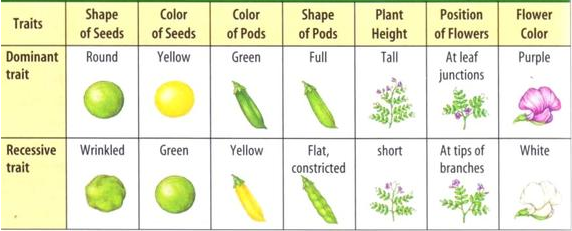
Reason of selecting Garden Peas
Mendel selected garden peas (Pisum sativum) for his experiment because of several reasons –
- Presence of several contrasting characters that can be studies easily.
- Short life span.
- Pollination of pea flowers is easier and therefore, hybrids produced were fertile.
- Flowers show self – pollination and reproductive whorls being enclosed by corolla
Working method
Mendel carried out his experiment with proper planning and his success depends on the working method he adopted.
- He studied single character at a time.
- Mendel used all available techniques in order to avoid cross pollination by undesirable pollen grains.
- He adopted concepts of statistics and mathematics so as to analyze the results obtained by him.
Inheritance of One Gene
Mendel carried out hybridization experiment, whereby he crossed tall and dwarf pea plant to study the inheritance of one gene. He collected the seeds produced as a result of this cross and grew first hybrid generation referred as first filial or Filial1 progeny or generation. Mendel observed that all F1 plants were tall and none were dwarf. Similar observations were found in other characters as well.
Then, Mendel self – pollinated the tall F1 plants and found some of the offspring were dwarf in F2 generation, i.e. the character that was hidden in F1 was now expressed in F2. The portion of dwarf plants were 1/4th of the F2 plants while 3/4th of the F2 plants were tall.
Following diagram shows the outcome of first hybrid generation, where at F1 Mendel observed all tall pea plants. Simultaneously, we can also see the dwarf character existed in F2 stage:
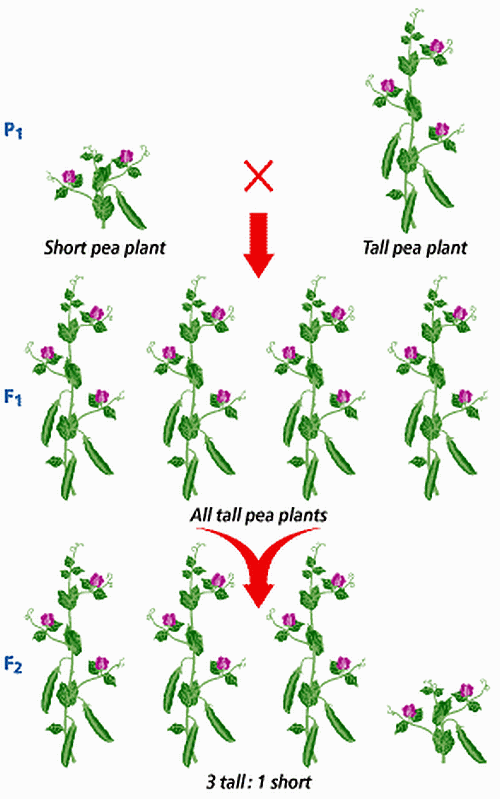
Based on these observations, Mendel proposed that something stably passed down, from parent to offspring, unchanged via gametes, over successive generations and called them as genes. Genes are the unit of inheritance and consist of information required to express the particular trait in an organism.
If we alphabetically represent each gene, whereby capital letter for tall and small letter for short, then the traits will be expressed as follows:
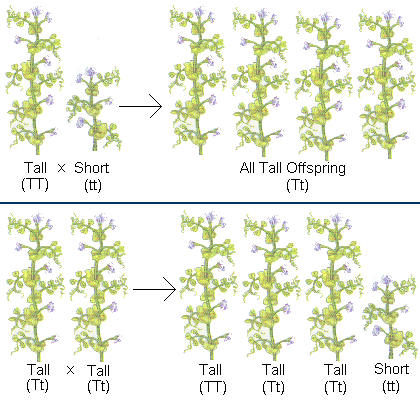
In the above image, T is used for tall trait and t is used for dwarf trait. Thus, T and t are allele to each other. Mendel also concluded that in case of true breeding, dwarf or tall pea variety of allelic pair are identical or homozygous (represented as TT or tt). On the other hand, Tt is considered as heterozygous.
Mendel’s work and result
After experimentation, Mendel proposed several laws that are referred as “Laws of heredity.”
- Law of dominance – “This law states that when two contrasting factors for two characters come together in an organism, only one is expressed externally and shows visible effect.” The character which is visibly present is called dominant while which remains hidden or do not express in recessive.” Thus, according to it –
- Factors are the discrete units that control characters.
- These factors occur in pair.
- In case of dissimilar pair, one pair is dominant while other is recessive.
- Law of segregation or Purity of Gametes – “This states that alleles separate or segregate during gamete formation, and randomly unite at fertilization.” When F2 generation was produced by allowing F1 hybrid to self – pollinate, to find out segregation or separation it was observed that both dominant and recessive plants appeared in 3:1 ratio.” In other words, alleles do not show any blending; rather both the characters are recovered in F2. Although, parents have both alleles but the gamete receive only one of the two factors. It is important to note that, homozygous produce all similar gametes while heterozygous produce two kinds of gametes.
- Law of independent assortment – “This law states that when two or more characteristics are inherited, individual hereditary factors assort independently during gamete production, giving different traits an equal opportunity of occurring together.” To prove this, he did a dihybrid cross. He crossed homozygous dominant smooth and yellow seeded (YYRR) with homozygous recessive wrinkled and green seeded (yyrr) plants. The F1 hybrid was self – pollinated and F2 generation was obtained with the phenotypic ratio of 9:3:3:1 and genotypic ratio of 1:2:1:2:4:2:1:2:1.”
Inheritance of Two Genes
Mendel also researched with inheritance of two genes, but crossing over pea plant with two contrasting traits, such as plant with seeds with round and green color and plant with seeds with yellow and wrinkled shape and found that the seeds resulted from this crossing over was yellow colored and round shaped. He thus, concluded that yellow color is dominant over green and round shape is dominant over wrinkled shape.
Now let us consider several genotype symbols –
Y = dominant yellow seed color
y = recessive green seed color
R = round shaped seeds
r = wrinkled seed shape
The genotype of parents is written as follows – RRYY and rryy.
Following figure shows the cross between these two parents produced the following result:

Result of the Dihybrid Cross
Phenotype Ratio =
Round Yellow: Round Green: Wrinkled Yellow: Wrinkled Green
9 : 3 : 3 : 1
In the above figure, the gametes RY and ry unite on fertilization and produce RrYy hybrid at F1. When Mendel self – hybridized F1 plants, he found 3/4th of F2 plants had yellow seeds while 1/4th had green. Thus, the yellow and green color segregated in a ratio 3:1. In the similar manner, round and wrinkled seeds also segregated in the ratio 3:1.
Law of Independent Assortment
Referring the above image of dihybrid cross, the phenotypes round yellow: wrinkled yellow: yellow round: wrinkled and green appeared in the ration 9:3:3:1.
According to the law of independent assortment “when two pairs of traits are combined in a hybrid, segregation of one pair of characters is independent of the other pair of characters.”
Chromosomal Theory of Inheritance
Chromosomal Theory of Inheritance was proposed by Boveri and Sutton in 1902. Sutton described Mendel principle of Inheritance on cytological basis. According to him, during meiosis, one member of the pair of homologous chromosome goes to one daughter cell and second to another daughter cell. The principle of Independent Assortment (proposed by Mendel) found cytological proof from the fact that member of one pair of homologous chromosomes independently move to poles towards another pair. Sutton calculated the number of combinations of chromosomes in same manner as gametes was calculated by Mendel. He also found that the number of chromosomes combinations were same as Mendel postulated during crosses of pea plant. During the independent assortment of chromosomes, four types of allelic combinations are made which are in the phenotype ratio 9:3:3:1 at F2.
Following figure shows Chromosomal Theory of Independence. It is clear that the genes and chromosomes arrange themselves in homologous manner and separate in two different ways during meiosis. This results in four types of allelic combination and at F2 the phenotypic ratio is 9:3:3:1.
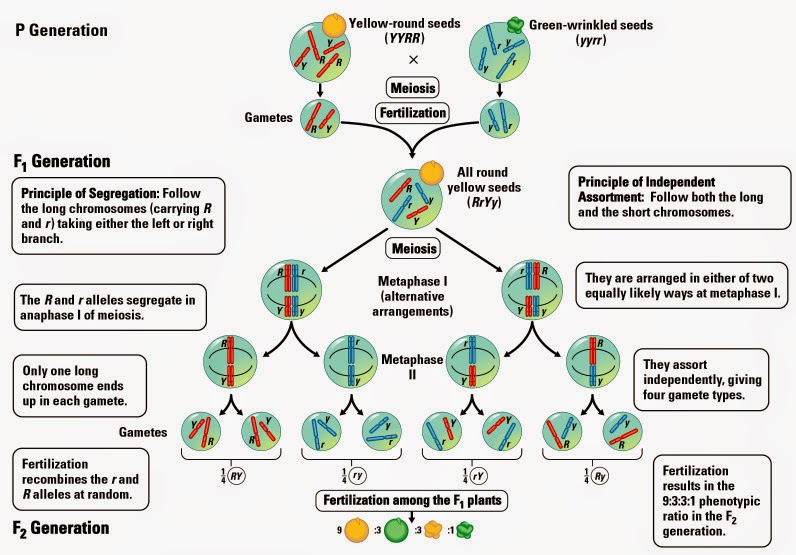
Arguments of Sutton and Boveri for Chromosomal Theory of Inheritance
- Since eggs and sperm cells are the one bridge that is transferred from one generation to another. It implies that all the heredity characters are included in them.
- During maturation, the sperm cell practically loses all its cytoplasm. But sperm contributes heredity similar to eggs; therefore the heredity factors are carried in nucleus.
- Similar to Mendelian factors, chromosomes are also found in pairs.
- Union of egg and sperm re – establishes new organism with two sets of chromosomes previously seen in the body cells of parent organism.
- Chromosomes divide accurately during cell division and this gives an idea that genes are carried on chromosomes.
- Chromosomes segregate during meiosis.
- Member of chromosome pair also segregate independently of other chromosome pairs. Genes, proposed by Mendel also segregate independently.
Sex Determination
Definition of Sexual differentiation in Humans: “Sexual Differentiation in Humans is the process of development of sex differences in humans.” It is the process of development of different genitalia and the internal genital tracts, body hair, breasts, etc. play the significant role in sex determination.
The development of sexual differences in human is due to the presence of sex chromosome. It begins with XY sex – determination system followed by the complex mechanism for the development of phenotypic differences between female and male humans. Female has two X chromosomes while male have one X chromosome and one Y chromosome. At the early developmental stage of an embryo, both sexes possess equivalent internal structures, referred as mesonephric ducts and paramesonephric ducts.
In humans, sex determination mechanism is referred as XY type. Out of 23 pair of chromosomes, 22 pairs are exactly same in case of both male and female. These chromosomes are called autosomes. A pair of X chromosomes is present in female; 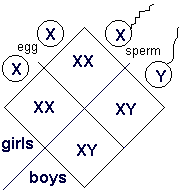 while X and Y chromosome are the determinant of male characteristics. During spermatogenesis, two types of gametes are produced in which 50% of sperm carry X chromosome while another 50% of the sperm carry Y chromosome. There is equal probability of fertilization of the ovum with sperm carrying X or Y chromosome. Thus, it is evident that sex of the child depends on the sperm and during pregnancy; there is always 50% probability of either a female or a mal child.
while X and Y chromosome are the determinant of male characteristics. During spermatogenesis, two types of gametes are produced in which 50% of sperm carry X chromosome while another 50% of the sperm carry Y chromosome. There is equal probability of fertilization of the ovum with sperm carrying X or Y chromosome. Thus, it is evident that sex of the child depends on the sperm and during pregnancy; there is always 50% probability of either a female or a mal child.
Following image shows the sex determination in male and female. Here an egg comprises of XX chromosome and sperm consist of XY chromosome.
Mutation
“Mutation is a phenomenon which results in alteration of DNA sequences and consequently results in changes in genotype and the phenotype of an organism.” Mutation is also the phenomenon that results to variation in DNA.
Following image shows mutation where the DNA is changed to mutant copy rather than original one:
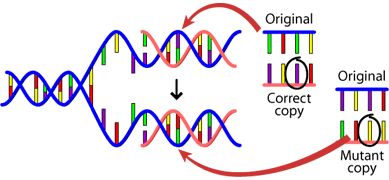
Genetic Disorders
- Pedigree Analysis – In pedigree analysis, the inheritance of a particular trait is represented in the family tree over generations. It is the strong tool, which helps in studying the inheritance of specific trait, disease or abnormality. It is important to note that each and every feature of an organism is controlled by one or other gene which is located on DNA present on chromosome. However, alteration or changes takes place occasionally and such an alteration is called mutation. Number of disorders has been found that are associated with the inheritance of altered or changed genes.
- Mendelian Disorders – These disorders are determined by mutation in a single gene. The pattern of inheritance of such disorders are traced and studied by Pedigree Analysis. Most prevalent Mendelian disorders are Sickle – cell anemia, hemophilia, cystic fibrosis, thalassemia, color blindness, phenylketonuria, etc. These disorders can be dominant or recessive as well.
- Hemophilia – It is sex linked recessive disease which is transmitted from unaffected carrier female to some of the male progeny. In this disease, a simple cut results in non – stop bleeding in an affected individual. Possibility of female of becoming hemophilic is extremely rare because mother needs to be carrier in this case and father needs to be hemophilic. Following figure shows the condition of hemophilia in an individual. The blood of such person is not able to clot:
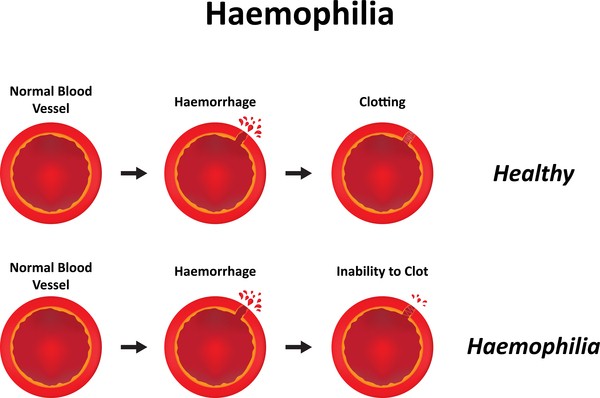
- Sickle cell anemia – It is autosome linked recessive trait which is transmitted when both the parents are carrier for the gene. This disease is controlled by single pair of allele, HbA and HbS. Heterozygous individual (HbAHbS) are apparently unaffected but they are the carrier of the diseases. Following figure shows the condition of sickle cell anemia in an individual where sickle cells block the flow of blood while normal red blood cells results in free flow of blood vessels:
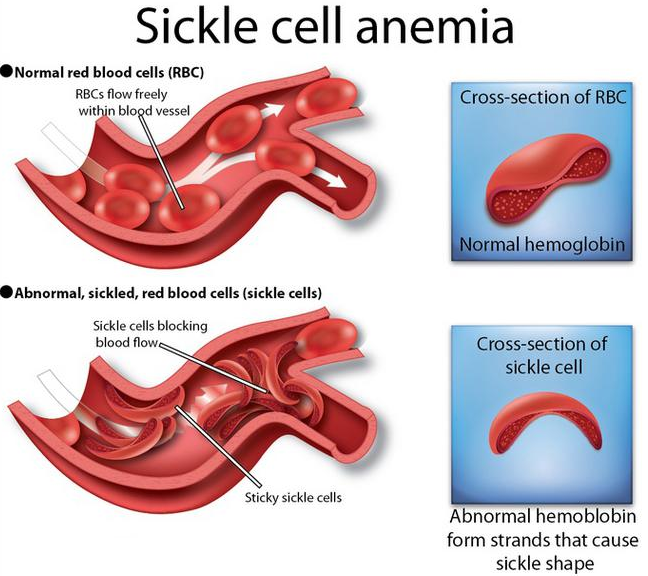
- Phenylketonuria – It is inherited as autosomal recessive trait and is an inborn error of metabolism. The individual suffering from phenylketonuria lacks an enzyme that transform amino acid phenylalanine into tyrosine, due to which phenylalanine is accumulated and converted into phenyl pyruvic acid and other derivatives. These accumulate in brain and thereby result in mental retardation.
- Chromosomal Disorders – These disorders are caused due to lack of excess or abnormal arrangement of one or more chromosomes. “Failure of segregation of chromatids during cell – division results in the gain or loss of chromosome(s), called aneuploidy. For instance, Down’s syndrome results in the gain of extra copy of chromosome 21. In the same way, Turner’s syndrome is resulted from the loss of an X chromosome in human females. “Failure of cytokinesis after telophase stage of cell division results in an increase in a whole set of chromosomes in an organism and this phenomenon is called polyploidy.” This condition is often observed in plants.
- Down’s syndrome or Trisomy 21 – It was first described by Langdon Down in the year 1866 and occurs due to the presence of additional copy of chromosome number 21. The person suffering from this disorder is short statured with furrowed tongue, short round head and partially open mouth. Psychomotor, mental and physical development is retarded in such individuals.
- Klinefelter’s syndrome or 47, XXY or XXY – This disorder results due to the presence of additional copy of X chromosome. Such individuals have masculine development; followed by expression of feminine development as well (It includes development of breast). The individuals suffering from this disorder are sterile.
- Turner’s syndrome or 45,X – This disorder occurs due to the absence of one X chromosome. Such females are sterile and lack secondary sexual characters.
Frequently Asked Questions
Q1: What are true – breeding lines?
Answer: “A true – breeding line is one that having undergone continuous self – pollination, shows the stable trait inheritance and expression for several generations.”
Q2: What are alleles?
Answer: “Alleles are the alternate pair of the same gene which is present on the homologous pair of chromosome.”
Q3: What is the difference between homozygous and heterozygous?
Answer:
| Homozygous | Heterozygous |
| It gives rise to similar homozygous individuals and is usually represented as tt or TT. | It produces offspring of different genotype and is represented as Tt or tT. |
| Both the alleles have similar traits. | Both the alleles have contrasting traits. |
| Homozygous individuals carry either recessive or dominant allele but not both. | Heterozygous individuals carry both dominant and recessive alleles. |
| It produces one type of gametes. | It produces two types of gametes. |
| It does not display extra vigour. | It displays extra vigour and is referred as heterosis or hybrid vigour. |
Q4: What is incomplete dominance?
Answer: “It is a form of intermediate inheritance in which one allele for a specific trait is not completely expressed over its paired allele.” It results in third phenotype in which the expressed trait is the combination of both the trait of parents. It is also referred as semi dominance or partial dominance.
Example of Incomplete Dominance: Pink roses are the example of incomplete dominance.
Following figure shows incomplete dominance, whereby RR is red rose and rr is white rose. At F1, they produce Rr and all offspring are of pink color.
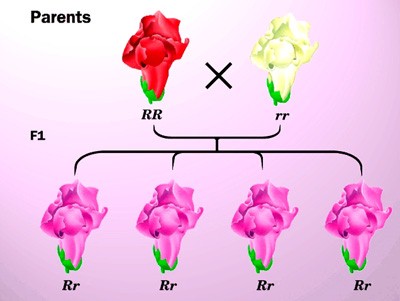
Q5: What is the difference between incomplete dominance and co dominance?
Answer: Incomplete dominance occurs when the alleles received by parents are neither recessive nor dominant rather blend together and produce new trait that is somewhere between the two traits. On the other hand, co dominance is also the similar phenomenon where neither dominant nor recessive trait is displayed, rather both the alleles mix up and shows in the offspring. For instance, red and while flowered rose plant may produce red or white flowers but white flower with freckles of red spots.
Following diagram shows the difference between incomplete and co-dominance:

Q6: What is point mutation?
Answer: “Point Mutation is a change in one or a few base pairs in a gene.” There are two Types of point mutation –
- Base substitution:– It occurs when one base is switched out with another base.
- Frame shift mutation:– It occurs when one base is added or removed.
Following figure shows two types of point mutation, i.e. base substitution and base shift mutation.
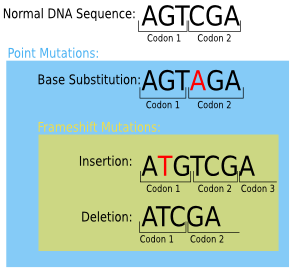
Topic 3.4 Inheritance

Genetic inheritance is a basic principle of genetics. It explains how characteristics are passed from one generation to the next.
Genetic inheritance occurs due to genetic material in the form of DNA being passed from parents to their offspring. When organisms reproduce, all the information for growth, survival and reproduction for the next generation is found in the DNA passed down from the parent generation.
Much of our understanding of inheritance began with the work of a monk by the name of Gregor Mendel. His experiments and ‘Laws of Inheritance’ provide the foundations for modern genetic.
This unit will take 4 school days
Essential idea:
- The inheritance of genes follows patterns.
Nature of science:
- Making quantitative measurements with replicates to ensure reliability. Mendel’s genetic crosses with pea plants generated numerical data. (3.2)
- Outline why Mendel’s success is attributed to his use of pea plants.
- Explain discoveries made by Thomas Andrew Knight in relation to current understanding of genetics.
- List three biological research methods pioneered by Mendel.
3.4.U1 Mendel discovered the principles of inheritance with experiments in which large numbers of pea plants were crossed.
- Describe Mendel’s pea plant experiments.
Gregor Mendel was an Austrian monk who developed the principles of inheritance by performing experiments on pea plants. Mendel discovered the principles of inheritance with experiments in which large numbers of pea plants were crossed
- Some characteristics cannot be inherited
- Mendel’s experiment used different types of pea plants, each of which reliably had the same characters when grown on its own
- Replicates and reliability in Mendel’s experiments
- Making quantitative measurements with replicates to ensure reliability: Mendel’s genetic crosses with pea plants generated numerical data
- Male and female parents contribute equally to offspring
Mendel drew the following conclusions:
- Organisms have discrete factors that determine its features (these ‘factors’ are now recognised as genes)
- Furthermore, organisms possess two versions of each factor (these ‘versions’ are now recognised as alleles)
- Each gamete contains only one version of each factor (sex cells are now recognised to be haploid)
- Parents contribute equally to the inheritance of offspring as a result of the fusion between randomly selected egg and sperm
- For each factor, one version is dominant over another and will be completely expressed if present
Certain rules can be established:
- Law of Segregation: When gametes form, alleles are separated so that each gamete carries only one allele for each gene
- Law of Independent Assortment: The segregation of alleles for one gene occurs independently to that of any other gene
- Principle of Dominance: Recessive alleles will be masked by dominant alleles
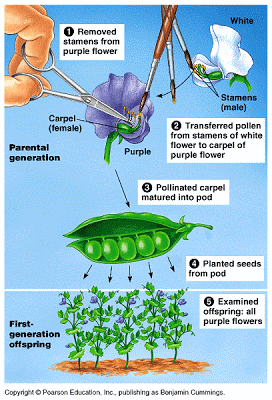 | 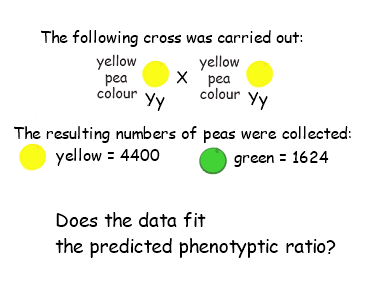 |
3.4.U2 Gametes are haploid so contain only one allele of each gene.
- Define gamete and zygote.
- State two similarities and two differences between male and female gametes
Gametes are haploid sex cells formed by the process of meiosis – males produce sperm and females produce ova
- During meiosis I, homologous chromosomes are separated into different nuclei prior to cell division
- As homologous chromosomes carry the same genes, segregation of the chromosomes also separates the allele pairs
- Consequently, as gametes contain only one copy of each chromosome they therefore carry only one allele of each gene
- Cells that fuse together to produce the single cell that is the start of a new life (known as sex cells)
- Male gamete is smaller than the female one – due to this male gametes can move whereas the female gamete moves less or not at all
- Sperm has a smaller volume than the egg cell – using the tail to swim to the egg
- Genes are passed through to offspring by gametes
- Gametes contain one chromosome of each type of haploid
- Nucleus of a gamete only has one allele of each gene
- Female/male parents make an equal genetic contribution to their offspring
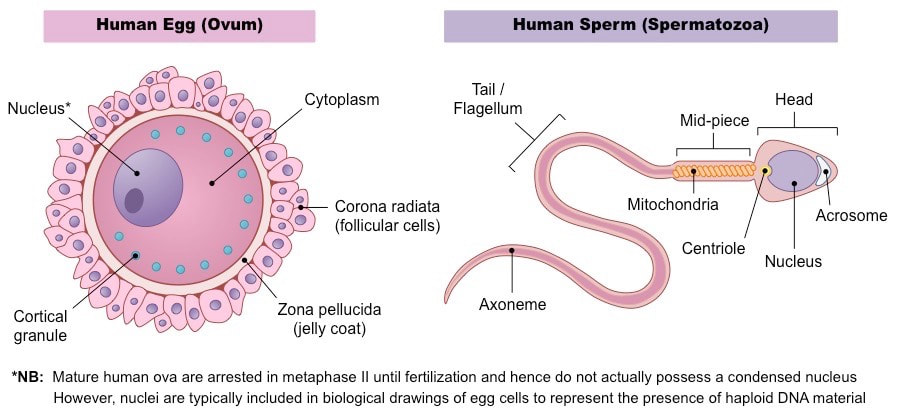
3.4.U3 The two alleles of each gene separate into different haploid daughter nuclei during meiosis.
- State the outcome of allele segregation during meiosis.
- During meiosis a diploid nuclei in a germ cell divides to produce 4 haploid nuclei
- If an individual has two of the same allele AA for a particular gene, all 4 haploid cells will contain the allele A. This is the same if the alleles for the gene are aa
- If an individual has two different alleles for a particular gene such as Aa, the haploid gametes will contain 50% A and 50% a for that specific gene
- The separation of the alleles into different nuclei is called segregation
3.4.U4 Fusion of gametes results in diploid zygotes with two alleles of each gene that may be the same allele or different alleles.
- Outline the possible combination of alleles in a diploid zygote for a gene with two alleles.
- Outline the possible combination of alleles in a diploid zygote for a gene with three alleles
- When the gametes (n) fuse to form a zygote (2n), two copies of each gene exist in the diploid zygote
- The zygote may contain two of the same allele AA or aa or two different alleles such as Aa
For any given gene, the combination of alleles can be categorised as follows:
- If the maternal and paternal alleles are the same, the offspring is said to be homozygous for that gene
- If the maternal and paternal alleles are different, the offspring is said to be heterozygous for that gene
- Males only have one allele for each gene located on a sex chromosome and are said to be hemizygous for that gene
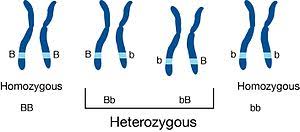 | 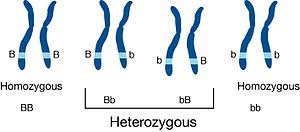 |
3.4.U5 Dominant alleles mask the effects of recessive alleles but co-dominant alleles have joint effects.
- Define dominant allele and recessive allele.
- State an example of a dominant and recessive allele found in pea plants.
- State the usual cause of one allele being dominant over another
- Define codominant alleles.
- Using the correct notation, outline an example of codominant alleles
For example, if B is dominant for brown hair color and little b is recessive for blonde hair colour, an individual that is BB (homozygous dominant) will have brown hair.
If the individual has the genotype Bb (heterozygous), they will also have brown hair, as the dominant B is masking the expression of b
If the individual has the genotype bb (homozygous recessive), that person will have blonde hair
3.4 U6 Many genetic diseases in humans are due to recessive alleles of autosomal genes, although some genetic diseases are due to dominant or co-dominant alleles.
- Define “carrier” as related to genetic diseases.
- Explain why genetic diseases usually appear unexpectedly in a population
Many genetic diseases are caused by recessive alleles contained on the autosomal chromosomes (chromosome 1-22). The disease would only be expressed if an individual has two recessive alleles (i.e. aa). If an individual has one of the dominant alleles (i.e. Aa), they will not show symptoms of the disease. These people are known as carriers. They can pass this allele on to their offspring.
If the other parent is also a carrier then their offspring have a 25% chance of getting the disease. A small number of diseases are co-dominant, such as sickle cell anemia which was studied in 3.1. HAHA – do not have sickle cell anemia, HAHS – mild anemia, HSHS – severe anemia. An example of a recessive genetic disease is cystic fibrosis and a dominant disease is Huntington’s Disease
3.4.U7 Some genetic diseases are sex-linked. The pattern of inheritance is different with sex-linked genes due to their location on sex chromosomes.
- Describe why it is not possible to be a carrier of a disease caused by a dominant allele.
- Outline inheritance patterns of genetic diseases caused by dominant alleles
- Define sex linkage
- These are patterns of inheritance where the ratios are different in males and females because the gene is located on the sex chromosomes
- Generally, sex-linked diseases are on the X chromosome
- Sex-linked inheritance for eye colour is observed and studied in Drosophila (fruit flies)
- Explain sickle cell anemia as an example of a genetic disease caused by codominant alleles.
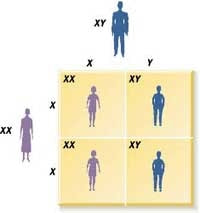 | 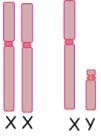 |
3.4.U8 Many genetic diseases have been identified in humans but most are very rare.
- Outline Thomas Morgan’s elucidation of sex linked genes with Drosophila.
- Use correct notation for sex linked genes.
- Describe the pattern of inheritance for sex linked genes.
- Construct Punnett grids for sex linked crosses to predict the offspring genotype and phenotype ratios.
- There are over 6000 identified genetic disorders, most of these diseases are caused by rare recessive alleles that follow Mendelian genetics
- Even though this might seem like a lot, most of the human population does not suffer from a genetic disorder and since you need both recessive alleles, these diseases are very rare
3.4.U9 Radiation and mutagenic chemicals increase the mutation rate and can cause genetic diseases and cancer
- List five example genetic diseases.
- Explain why most genetic diseases are rare in a population.
This is in general why you don’t expose yourself to gamma rays and dangerous chemicals.
- new alleles are formed form other alleles by gene mutation
- gene mutation is a random change to the base sequence of a gene
- Mutation can increase through enough energy to cause chemical changes in DNA // some chemical substances cause chemical changes
3.4.A1 Inheritance of ABO blood groups
- Describe ABO blood groups as an example of complete dominance and codominance.
- Outline the differences in glycoproteins present in people with different blood types
- Human blood types are an example of both multiple alleles (A, B, O) and co-dominance (A and B are co-dominant).
- Co-dominant alleles such as A and B are written as a superscript (IA and IB). The (I) represents immunoglobulin. Blood type O is represented by (i).
- Both IA and IB are dominant over the allele (i).
- A, B and O alleles all produce a basic antigen (glycoprotein) on the surface of the red blood cells
- The allele for blood type B alters the basic antigen by adding a galactoseto the glycoprotein. Individuals that do not have this allele and are exposed to blood type B, will produce Anti-B antibodies that will attack and destroy these red blood cells (RBC)
- The allele for blood type A alters the basic antigen by adding an acetylgalactosamine. So individuals that do not have the A allele will produce Anti-A antibodies that will attack and destroy these RBC’s
- The allele for blood type O produces the basic antigen that will be present on the cell membrane of these RBC’s. Individuals with blood type O will produce both Anti-A and Anti B antibodies if exposed to either A or B blood cells
- Individuals that have both A and B alleles will have both of the antigen modifications. Hence, the alleles for A and B are co-dominant. If exposed to blood type A or B, no Anti-A or Anti-B antibodies will be produced.
- If individuals with blood type A, B or AB are exposed to blood type O, no immune response will occur because blood type O only contains the basic antigen
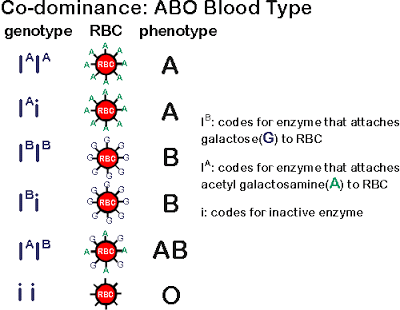
- Describe the cause and effect of red-green color blindness.
- Explain inheritance patterns of red-green color blindness.
- Describe the cause and effect of hemophilia.
- Explain inheritance patterns of hemophilia
- Color blindness and hemophilia are both examples of sex linkage.
- Color blindness and hemophilia are produced by a recessive sex-linked allele on the X chromosome.
- X-linked recessive diseases such as color blindness and hemophilia are more common in males because males only carry one X chromosome, therefore if they inherit the X chromosome with the disease, they will have the disease.
- On the other hand, since females have two X chromosomes, if they inherit one X chromosome with the disease; they have another normal X chromosome to make the correct gene product. These individuals are considered carriers.
- Since male offspring have to receive a Y from their father, they will always inherit the colorblind or hemophilia allele from their mother; not the father.
- Males that have the disease can only pass the colorblind or hemophilia allele onto their daughters. Their sons will receive the Y chromosome.
- Females can only get X-linked recessive diseases if the mother happens to be a carrier of the disease (or has the disease) and the father also has the disease.
- Therefore sex-linked diseases are rare in females.
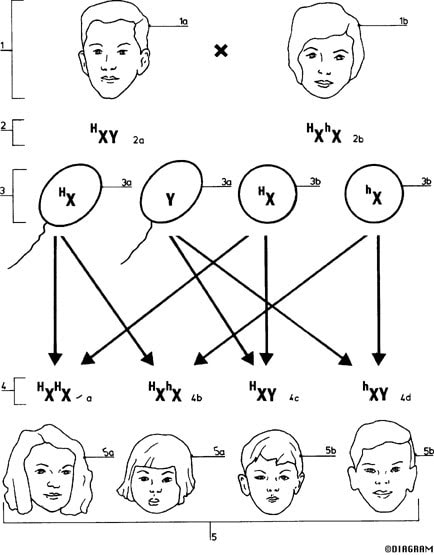 | 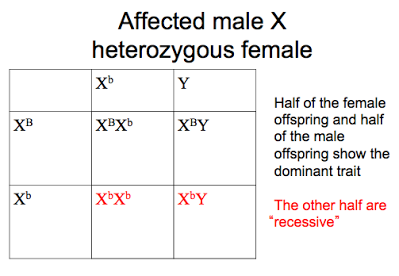 |
3.4.A3 Inheritance of cystic fibrosis and Huntington’s disease.
- Describe the relationship between the genetic cause of cystic fibrosis and the symptoms of the disease.
- Outline the inheritance pattern of cystic fibrosis.
- Outline the inheritance pattern of Huntington’s disease.
- List effects of Huntington’s disease on an affected individual
Cystic Fibrosis
Cystic fibrosis is a autosomal recessive disease caused by an allele of the CFTR gene on chromosome 7
The CFTR gene codes for a chloride ion channel protein that transports chloride ions into and out of cells. Chloride is a component of sodium chloride, a common salt found in sweat. Chloride also has important functions in cells; for example, the flow of chloride ions helps control the movement of water in tissues, which is necessary for the production of thin, freely flowing mucus.
Mutations in the CFTR gene disrupt the function of the chloride channels, preventing them from regulating the flow of chloride ions and water across cell membranes. As a result, cells that line the passageways of the lungs, pancreas, and other organs produce mucus that is unusually thick and sticky. This mucus clogs the airways and various ducts, causing the characteristic signs and symptoms of cystic fibrosis
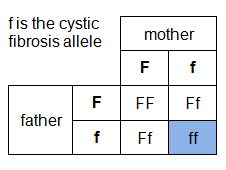
- Humans have two copies of the Huntingtin gene (HTT), which codes for the protein Huntingtin (Htt)
- Huntington’s disease is dominantly inherited. Meaning only one bad copy of the gene from either the mother or father will result in Huntington’s disease.
- Therefore, children of people affected with the disease have a 50% chance of getting that allele from an affected parent.
- If both parents have Huntington’s disease, offspring have a 75% chance of being affected by the disease.
- Huntington’s disease is a neurodegenerative genetic disorder that affects muscle coordination and leads to mental decline and behavioral symptoms
- In Huntington’s disease, a repetition of a CAG sequence in the gene encoding for the protein Huntingtin makes it clump together in our brain cells, ultimately making the brain cell die.
- The exact mechanism of the disease is still being researched; however, this is what is current research suggests.
- The repetitive glutamates (CAG) in the Huntington protein change the shape of the brain cells, affecting their function. The glutamate sends signals that constantly over-excite brain cells. Their overexcitement leads to cell damage, and ultimately cell death.
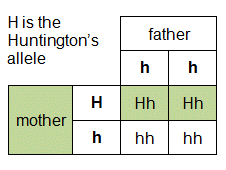
The radioactive isotopes released from the blasts at Hiroshima and Nagasaki and the nuclear plant failure at Chernobyl released radioactive isotopes into the air. After the bombing, 17,500 of the survivors developed tumors but only 850 of those could be attributed to the radioactive isotopes released from the bomb. As for mutations in children, there has been no evidence found but there were probably some (they were just not statistically significant. The general idea is that the bomb did not have the radioactive fallout most believe it to have had
Chernobyl, on the other hand, had far-reaching environmental effects. Pine trees in a 4 square kilometer area from the reactor turned brown and died. Horses and cattle near the plant died due to damage in their thyroid glands, there was an accumulation of radioactive caesium in fish as far away as Germany. 6000 cases of thyroid cancer have been linked to the accident, however, there is no clearly demonstrated increase in leukemia and other “solid cancers. However, animal life has started to thrive in the area because humans can’t live there.
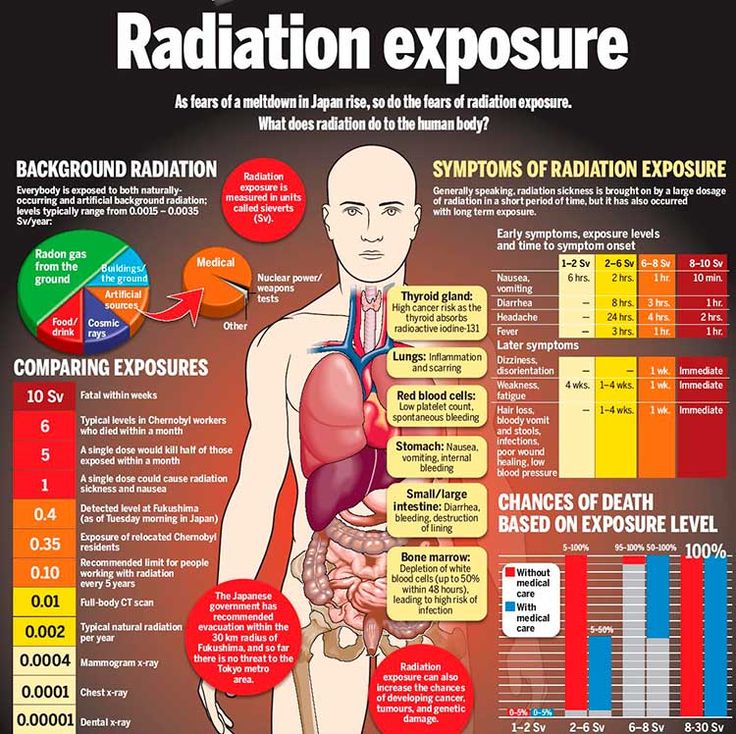
3.4.S1 Construction of Punnett grids for predicting the outcomes of monohybrid genetic crosses.
- Define monohybrid, true breeding, hybrid, F1 and F2.
- Determine possible alleles present in gametes given parent genotypes.
- Construct Punnett grids for single gene crosses to predict the offspring genotype and phenotype ratios
- Monohybrid inheritance is the inheritance of a single gene.
- The trait coded for by the gene is controlled by different forms of the gene called alleles.
- A Punnett square or grid is a tool used to solve genetic problems.
- For example:
- Mendel studied many different traits related to pea plants.
- One example is seed color. In pea plants, yellow seeds are dominant over green peas.
- If a pea plant that is heterozygous for yellow peas is crossed with a plant with green peas, what are the genotypes and phenotypes of the first generation (F1) of pea plants?
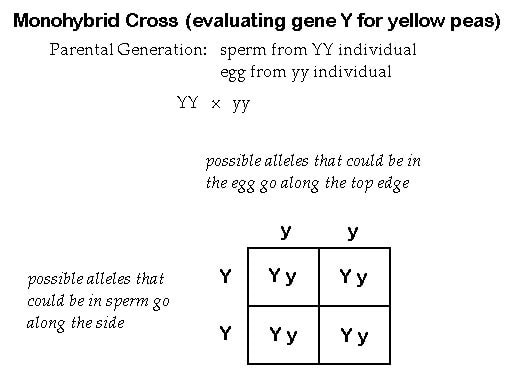
3.4.S2 Comparison of predicted and actual outcomes of genetic crosses using real data.
- Explain the reason why the outcomes of genetic crosses do not usually correspond exactly with the predicted outcomes.
- Describe the role of statistical tests in deciding whether an actual result is a close fit to a predicted result.
3.4.S3 Analysis of pedigree charts to deduce the pattern of inheritance of genetic diseases.
- Outline the conventions for constructing pedigree charts.
- Deduce inheritance patterns given a pedigree chart
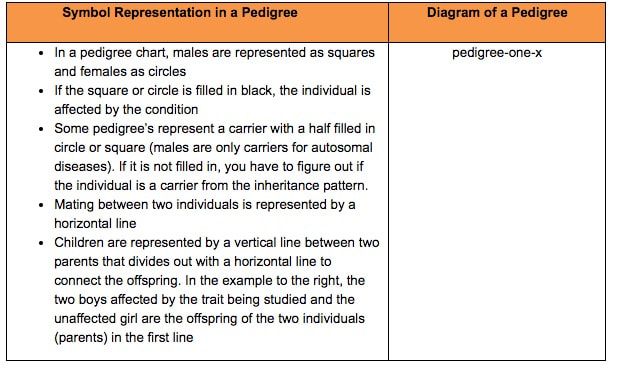
The pedigree above most likely displays an x-linked recessive disease because the mother is a carrier, and she gives the allele to her two sons but not her daughter. The daughter could have inherited the allele carrying the trait being studied. However, one can see in the 3rd generation, the boy does not have the trait. Since he does not have the trait, she probably did not inherit the affected allele. You would have to look to the next generation to get a better idea if the daughter was a carrier or not.
For co-dominance, the main letter should relate to the gene and the suffix to the allele; both upper case. For example, Roan horses that are co-dominant could be represented as RB and Rw, respectively. For sickle-cell anemia, HbA is normal and Hbs is sickle cell.